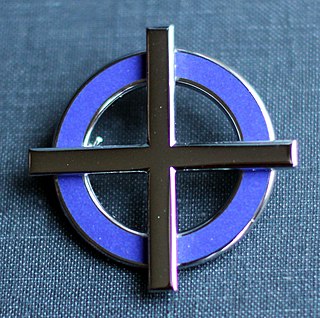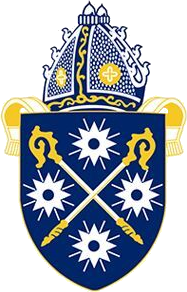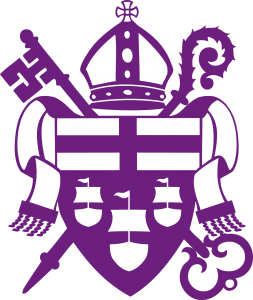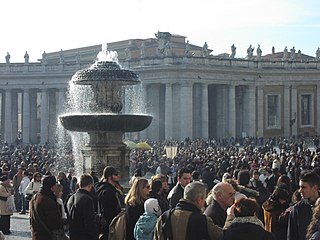Related Research Articles

A synod is a council of a Christian denomination, usually convened to decide an issue of doctrine, administration or application. The word synod comes from the Greek: σύνοδος [ˈsinoðos] meaning "assembly" or "meeting" and is analogous with the Latin word concilium meaning "council". Originally, synods were meetings of bishops, and the word is still used in that sense in Catholicism, Oriental Orthodoxy and Eastern Orthodoxy. In modern usage, the word often refers to the governing body of a particular church, whether its members are meeting or not. It is also sometimes used to refer to a church that is governed by a synod.

The Church of Ireland is a Christian church in Ireland and an autonomous province of the Anglican Communion. It is organised on an all-Ireland basis and is the second largest Christian church on the island after the Roman Catholic Church. Like other Anglican churches, it has retained elements of pre-Reformation practice, notably its episcopal polity, while rejecting the primacy of the Pope.

The Church in Wales is an Anglican Communion church in Wales, composed of six dioceses.

Personal prelature is a canonical structure of the Catholic Church which comprises a prelate, clergy and laity who undertake specific pastoral activities. The first personal prelature is Opus Dei. Personal prelatures, similar to dioceses and military ordinariates, are under the governance of the Vatican's Congregation for Bishops. On 4 August 2022, personal prelatures will be instead governed under the Dicastery for the Clergy. These three types of ecclesiastical structures are composed of lay people served by their own secular clergy and prelate. Unlike dioceses, which cover territories, personal prelatures—like military ordinariates—take charge of persons as regards some objectives regardless of where they live.

The Diocese of Sydney is a diocese in Sydney, within the Province of New South Wales of the Anglican Church of Australia. The majority of the diocese is evangelical and low church in tradition.
The post of Archbishop of Wales was created in 1920 when the Church in Wales was separated from the Church of England and disestablished. The four historic Welsh dioceses had previously formed part of the Province of Canterbury, and so came under its Archbishop. The new Church became the Welsh province of the Anglican Communion.

A canon is a member of certain bodies in subject to an ecclesiastical rule.

The Anglican Church of Canada is the province of the Anglican Communion in Canada. The official French-language name is l'Église anglicane du Canada. In 2017, the Anglican Church counted 359,030 members on parish rolls in 2,206 congregations, organized into 1,571 parishes. The 2011 Canadian Census counted 1,631,845 self-identified Anglicans, making the Anglican Church the third-largest Canadian church after the Catholic Church and the United Church of Canada. Like other Anglican churches, the Anglican Church of Canada's liturgy utilizes a native version of the Book of Common Prayer, the 1962 prayer book. A further revision, the 1985 Book of Alternative Services, has developed into the dominant liturgical book of the church.
In the Anglican Communion, the model of government is the 'Bishop in Synod', meaning that a diocese is governed by a bishop acting with the advice and consent of representatives of the clergy and laity of the diocese. In much of the Communion the body by which this representation is achieved is called the diocesan synod.

A licensed lay minister (LLM) or lay reader is a person authorised by a bishop in the Anglican Communion, including the Free Church of England, to lead certain services of worship, to preach and to carry out pastoral and teaching functions. They are formally trained and admitted to the office, but they remain part of the laity, not of the clergy.

The Anglican Diocese of Perth is one of the 23 dioceses of the Anglican Church of Australia. The constitution of the Diocese of Perth was passed and adopted in 1872 at the first synod held in Western Australia. In 1914, the Province of Western Australia was created and the diocesan bishop of Perth became ex officio metropolitan bishop of the new province and therefore also an archbishop.

The Diocese of Virginia is the largest diocese of the Episcopal Church in the United States of America, encompassing 38 counties in the northern and central parts of the state of Virginia. The diocese was organized in 1785 and is one of the Episcopal Church's nine original dioceses, with origins in colonial Virginia. As of 2018, the diocese has 16 regions with 68,902 members and 180 congregations.

The Anglican ministry is both the leadership and agency of Christian service in the Anglican Communion. "Ministry" commonly refers to the office of ordained clergy: the threefold order of bishops, priests and deacons. More accurately, Anglican ministry includes many laypeople who devote themselves to the ministry of the church, either individually or in lower/assisting offices such as lector, acolyte, sub-deacon, Eucharistic minister, cantor, musicians, parish secretary or assistant, warden, vestry member, etc. Ultimately, all baptized members of the church are considered to partake in the ministry of the Body of Christ.

The history of the Episcopal Church in the United States of America has its origins in the Church of England, a church which stresses its continuity with the ancient Western church and claims to maintain apostolic succession. Its close links to the Crown led to its reorganization on an independent basis in the 1780s. In the nineteenth and early twentieth centuries, it was characterized sociologically by a disproportionately large number of high status Americans as well as English immigrants; for example, more than a quarter of all presidents of the United States have been Episcopalians. Although it was not among the leading participants of the abolitionist movement in the early 19th century, by the early 20th century its social engagement had increased to the point that it was an important participant in the Social Gospel movement, though it never provided much support for the Prohibitionist movement. Like other mainline churches in the United States, its membership decreased from the 1960s. This was also a period in which the church took a more open attitude on the role of women and toward homosexuality, while engaging in liturgical revision parallel to that of the Roman Catholic Church in the post Vatican II era.

The General Synod of the Anglican Church of Canada is the chief governing and legislative body of the Anglican Church of Canada (ACC), the sole Canadian representative of the Anglican Communion. The first General Synod session was held in Toronto in 1893, with the proviso that the parameters of its authority would not undermine the local independence of dioceses.
A personal ordinariate for former Anglicans, shortened as personal ordinariate or Anglican ordinariate, is a canonical structure within the Catholic Church established in order to enable "groups of Anglicans" to join the Catholic Church while preserving elements of their liturgical and spiritual patrimony.

Catholic laity are the ordinary members of the Catholic Church who are neither clergy nor recipients of Holy Orders or vowed to life in a religious order or congregation. Their mission, according to the Second Vatican Council, is to "sanctify the world".

The Anglican Primate of Australia is the senior bishop and President of the General Synod of the Anglican Church of Australia. Between General Synods, the Primate is also President of the Standing Committee of the General Synod which takes responsibility for the affairs of the General Synod in between General Synod sessions. The Primate is elected from among the country's Anglican diocesan bishops, by a Board of Electors, comprising diocesan bishops and representative clergy and laity.

Margaret Rodgers AM was a prominent deaconess and lay-person in the Anglican Diocese of Sydney. Rodgers was Principal of Deaconess House, (1976–85), Research Officer for the Anglican General Synod (1985–93), chief executive officer of the Anglican Media Council (1994–2003), President of the New South Wales Council of Churches and Lay Canon of St Andrew's Cathedral, Sydney.
The Governing Body of the Church in Wales is the deliberative and legislative body of the Church in Wales, broadly speaking equivalent to the General Synod of the Church of England. The Governing Body usually meets twice each year to receive reports, discuss issues concerning the church and make decisions on matters brought before it.
References
- 1 2 "Representative Body: Background information". The Church in Wales. Retrieved 14 May 2016.
- ↑ "Exempt charities". GOV.UK. Retrieved 24 October 2018.
- ↑ Markham, Ian S.; Hawkins, J. Barney; Terry, Justyn; Steffensen, Leslie Nuñez (2013). The Wiley-Blackwell Companion to the Anglican Communion. John Wiley & Sons. pp. 521–523. ISBN 978-1-118-32086-0.
- ↑ Murden, Ben (24 September 2015). "The Representative Body of the Church in Wales Case Study". Phoenix Software. Retrieved 14 May 2016.
- ↑ "Welsh Church Act 1914, s. 13(2)". Legislation.gov.uk. Retrieved 2 July 2021.
- ↑ "Church in Wales to move HQ to one of most expensive developments in Cardiff", Wales Online (Accessed 19 May 2017)